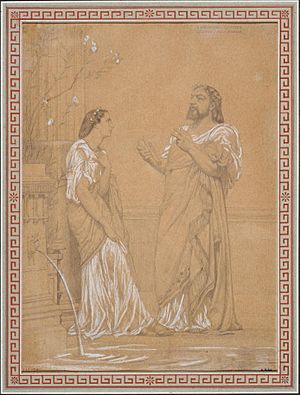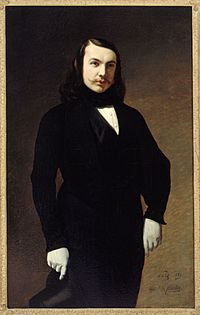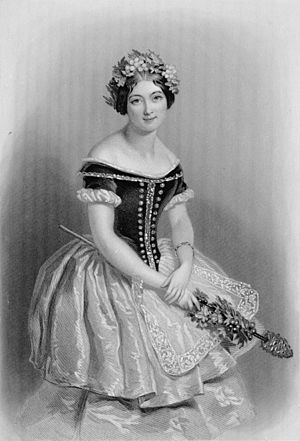Théophile Gautier facts for kids
Quick facts for kids
Théophile Gautier
|
|
|---|---|

Théophile Gautier photographed by Nadar
|
|
| Born | Jules Théophile Gautier 30 August 1811 Tarbes, France |
| Died | 23 October 1872 (aged 61) Neuilly-sur-Seine, France |
| Resting place | Cimetière de Montmartre |
| Occupation | Writer, poet, painter, art critic |
| Literary movement | Parnassianism, Romanticism |
| Signature | |
 |
|
Pierre Jules Théophile Gautier (born August 30, 1811 – died October 23, 1872) was a French writer. He was a poet, playwright, novelist, journalist, and a critic of art and literature.
Gautier was a big supporter of Romanticism, a style of art and literature that focused on emotion and imagination. However, his own work was unique and influenced many later writing styles, like Parnassianism and Symbolism. Many famous writers, including Balzac, Baudelaire, and Wilde, admired his writing.
Contents
Life and Early Years
Théophile Gautier was born on August 30, 1811, in Tarbes, a town in southwestern France. His father, Jean-Pierre Gautier, worked for the government and was quite educated. His mother was Antoinette-Adelaïde Cocard. In 1814, his family moved to Paris and lived in the old Marais area.
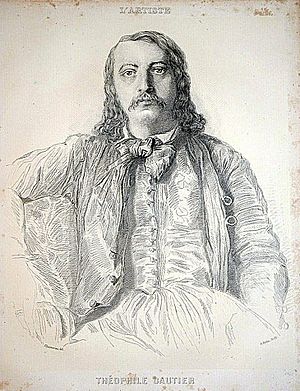
Gautier started school at the famous Lycée Louis-le-Grand in Paris. He only stayed for three months because he got sick. He finished his education at Lycée Charlemagne. However, his father taught him a lot, and by the age of eighteen, Gautier was very good at Latin.
While at school, Gautier became good friends with Gérard de Nerval. Through Nerval, Gautier met Victor Hugo, who was already a well-known writer. Hugo greatly influenced Gautier, who was an aspiring painter at the time. Hugo helped him discover his love for literature. Gautier is famous for wearing a bright red jacket to the first showing of Hugo's play Hernani. This was a bold fashion choice for the time!
After the 1830 Revolution, Gautier's family faced difficulties and had to move out of Paris. Gautier decided to stay in Paris with friends, living a fun, free-spirited life.
In late 1830, Gautier started going to meetings of "Le Petit Cénacle." This was a group of artists who met in the studio of Jehan Du Seigneur. The group was known for being wild and unique, a special place away from regular society.
Writing Career and Travels
Gautier began writing poetry in 1826. However, for most of his life, he wrote for various newspapers, especially La Presse. This job allowed him to travel to other countries and meet important people in society and the arts.
Gautier traveled a lot, visiting Spain, Italy, Russia, Egypt, and Algeria. His travels inspired many of his writings, including Voyage en Espagne (1843) and Voyage en Russie (1867). Many people consider Gautier's travel literature to be some of the best from the 1800s. He wrote in a personal style, sharing his own thoughts on art and culture.
Gautier loved Romantic Ballet. He wrote several stories for ballets, and the most famous one is Giselle. The first dancer to play Giselle was Carlotta Grisi. Gautier was very fond of her. He later had a long-term relationship with Carlotta's sister, Ernestina, who was a singer. They had two daughters, Judith and Estelle.
During the 1848 Revolution, Gautier wrote nearly a hundred articles in just nine months. He celebrated the new republic and the idea of individual freedom. Gautier became very important in the literary world when other famous Romantic writers were no longer active. He was the director of Revue de Paris from 1851 to 1856.
Gautier found regular journalism difficult. He called it "humiliating." Still, he became the editor of an important review called L’Artiste in 1856. In this review, he promoted the idea of "Art for art's sake," which means art should be created for its own beauty, not for any other purpose.
The 1860s were years of great literary fame for Gautier. Even though he was rejected by the French Academy three times, a very influential critic, Charles Augustin Sainte-Beuve, praised Gautier's work in several articles. In 1865, Gautier was invited to the prestigious salon of Princess Mathilde Bonaparte, who was a cousin of Napoleon III. The Princess offered Gautier a job as her librarian in 1868, which gave him access to the court of Napoleon III.
In 1862, Gautier was chosen as the chairman of the Société Nationale des Beaux-Arts (National Society of Fine Arts). He worked with famous painters like Eugène Delacroix and Édouard Manet.
During the Franco-Prussian War, Gautier returned to Paris when he heard the Prussian army was approaching. He stayed with his family through the invasion and the events of the Paris Commune. He died on October 23, 1872, at the age of sixty-one, from a heart condition. He is buried in the Cimetière de Montmartre in Paris.
After his death, a collection of poems called Le Tombeau de Théophile Gautier was published in 1873. It included tributes from writers like Victor Hugo.
Personal Life and Interests
When he was young, Gautier had a very "flamboyant" look. He stood out with his long hair and his famous red waistcoat.
He had a son, Théophile Gautier fils (1836-1904). Later, he had two daughters, Judith Gautier (1845-1917) and Estelle Gautier (1848-1914), with Ernesta Grisi.
Even though he was interested in "mystery, legend, and imagination," Gautier was not a religious person. He also did not believe in the supernatural.
Influences on Gautier
Early in his life, Gautier became friends with Gérard de Nerval. Nerval greatly influenced Gautier's early poetry and introduced him to Victor Hugo. Gautier shared Hugo's dislike for the theater of their time. Gautier also admired Honoré de Balzac for his important contributions to French literature.
Gautier was also greatly influenced by his friends. He honored them in his writings. For example, he dedicated his collection of Dernières Poésies to many of his friends, including Princess Mathilde Bonaparte.
Gautier as a Critic
Gautier spent most of his career as a journalist, writing for La Presse and later Le Moniteur universel. He saw journalism as a way to earn a living and travel. He started writing art criticism in 1831. In 1836, his career took off when he was hired as an art and theater columnist for La Presse. He also wrote for Le Figaro.
When he moved to Le Moniteur universel, Gautier wrote to inform the public and influence their choices. His job was similar to a modern book or theater reviewer. He also reviewed music, explaining it clearly even without using technical terms. For example, he wrote about the work of his friend Berlioz.
Gautier's literary criticism was more thoughtful. It was not for immediate commercial use but reflected his own tastes. Later in his life, he wrote long studies about famous writers like Gérard de Nerval, Balzac, and Baudelaire. Baudelaire even dedicated his famous book Les Fleurs du mal to Gautier, calling him "a perfect magician of French letters."
Art Criticism
Gautier started as a painter, so he contributed a lot to art criticism. Instead of focusing on traditional art analysis like color or composition, Gautier believed a critic should describe art so well that the reader could "see" it through their words. Many critics of his time believed in this idea of "transposition of art," meaning one art form could be described using terms from another.
Although Baudelaire is more famous as an art critic today, Gautier was highly respected by painters of his time. In 1862, he was elected chairman of the Société Nationale des Beaux-Arts.
Dance Criticism
From today's perspective, Gautier's writings about dance are his most important. The American writer Edwin Denby, a famous dance writer, called him "the greatest of ballet critics." Denby said Gautier wrote about dance from the viewpoint of someone enjoying a civilized show. He based his opinions on what he saw and felt, focusing on the dancer's physical form and energy. This way of writing about dance has been important ever since.
Gautier also wrote the story for the ballet Giselle, which is one of the most important ballets ever. His influence is still strong among choreographers (people who create dances) and dancers today.
In 2011, the Pacific Northwest Ballet performed a version of Giselle that was as close as possible to the original story and choreography from 1842, using old records.
Major Works
In many of Gautier's works, the story itself was less important than the joy of telling it. He liked a style that was both striking and refined.
Poetry Collections
- Poésies (1830): This collection of 42 poems was written when Gautier was 18. It was published during the July Revolution, so few copies sold. It was reissued in 1832 with more poems under the name Albertus.
- Albertus (1832): A long poem that makes fun of Romantic literature, especially spooky and supernatural tales. It tells the story of an ugly witch who turns into a beautiful young woman at midnight.
- Les Jeunes-France (1833): This book was a satire, meaning it made fun of Romanticism.
- La Comédie de la Mort (1838): In this work, Gautier focuses on the theme of death. For him, death was a scary and final end. He saw it as the ultimate escape from life's difficulties.
- España (1845): This collection of 43 poems was inspired by Gautier's trip to Spain in 1840. It covers Spanish language, music, and dance.
- Émaux et Camées ("Enamels and Cameos", 1852): This is considered his greatest poetic work. The title shows that Gautier focused more on the form and beauty of the poem itself, rather than just its emotional content. It started with 18 poems and later grew to 37.
- Dernières Poésies (1872): This collection includes earlier poems and unfinished pieces written shortly before his death. Many of these poems are sonnets dedicated to his friends.
Plays
Gautier did not see himself as a playwright, but more as a poet and storyteller. Many theaters were closed during the French Revolution of 1848, so it was hard for plays to be performed. Most of his plays were never published or were only accepted with difficulty.
Between 1839 and 1850, Gautier wrote all or part of nine different plays, including:
- Une Larme du diable ("The Devil's Tear", 1839): This play is like a medieval mystery play, which were religious dramas. It's humorous and talks about human love.
- Le Tricorne enchanté ("The Magic Hat", 1845): Set in the 17th century, this play is about an old man who wants to marry a woman who loves someone else. The old man is tricked, and the lovers get married.
- La Fausse Conversion ("The False Conversion", 1846): A satirical play that takes place in the 18th century. It expresses Gautier's view that women should be a source of pleasure or art for men.
- Pierrot Posthume (1847): A short, funny fantasy play inspired by the Italian Commedia dell'arte, which was popular in France. It has a typical love triangle and a happy ending.
Novels
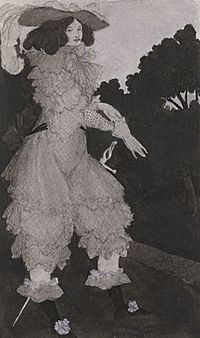
- Mademoiselle de Maupin (1835): This novel was originally supposed to be about the real-life French opera star Mlle. Maupin. Gautier changed the story into a love triangle. The main message of the novel is about the difficulties of human identity. Its famous introduction talks about "art for art's sake" and says "everything useful is ugly."
- Eldorado, ou Fortunio (1837): This fantasy story is set in Paris and is about a mysterious man named Fortunio, who grew up in India, and his French love, Musidora.
- Le Roman de La Momie ("The Romance of a Mummy", 1858): A historical novel set in Ancient Egypt. It includes the Biblical Exodus story.
- Captain Fracasse (1863): This book was promised much earlier but finally published in 1863. It's about a soldier named Fracasse and his adventures, full of bravery and excitement. It's like a classic fairy tale where everyone lives happily ever after.
Short Stories
- La Morte Amoureuse (1836): A classic supernatural tale where a priest is visited at night by a female vampire.
- One of Cleopatra's Nights and Other Fantastic Romances (1882): A collection of six of his short stories translated into English.
Travel Books
- The travels of Théophile Gautier – 4 Volumes.
- The travels of Théophile Gautier Vol 4
-
- Travels in Russia Vol 1
Gautier in Other Works
Two poems from "Émaux et camées" appear in Oscar Wilde's The Picture of Dorian Gray. The main character, Dorian, reads them after a murder.
Ernest Fanelli's Tableaux Symphoniques are based on Gautier's novel Le Roman de la Momie.
In Peter Whiffle by Carl Van Vechten, the main character Peter Whiffle says Gautier was a great influence on him.
Chronology of Works
- 1830: Poésies (Vol. I).
- 1831: First article in Le Mercure de France au XIXe siècle.
- 1832: Albertus.
- 1833: Les Jeunes France, Romans Goguenards.
- 1834-5: Published articles that later formed Les Grotesques.
- 1835-6: Mademoiselle de Maupin.
- 1836: Published "Fortunio" under the title "El Dorado".
- 1836: La Morte Amoureuse.
- 1838: La Comédie de la Mort.
- 1839: Une Larme du Diable.
- 1840: Le Pied de Momie.
- 1841: Premiere of the ballet, Giselle.
- 1843: Voyage en Espagne | Premiere of ballet, La Péri.
- 1845: Poésies (complete) | First performance of comedy "Le Tricorne Enchanté".
- 1847: First performance of comedy "Pierrot Posthume".
- 1851: Premiere of the ballet, Pâquerette.
- 1852: Un Trio de Romans | Caprices et Zigzag | Emaux et Camées | Italia.
- 1853: Constantinople.
- 1851: Premiere of the ballet, Gemma.
- 1855: Les Beaux-Arts en Europe.
- 1856: L’Art Moderne.
- 1858: Le Roman de la Momie | Honoré de Balzac.
- 1858-9: Histoire de l’Art Dramatique en France depuis Vingt-cinq Ans.
- 1861: Trésors d’Art de la Russie Ancienne et Moderne.
- 1863: Le Captaine Fracasse | Romans et Contes.
- 1863: De Profundis Morpionibus | Gautier preferred to keep that satirical work anonymous.
- 1865: Loin de Paris.
- 1867: Voyage en Russie.
- 1871: Tableaux de Siège: Paris 1870–1871.
- 1872: Emaux et Camées | Théâtre | Histoire du Romantisme.
Images for kids
See also
 In Spanish: Théophile Gautier para niños
In Spanish: Théophile Gautier para niños



